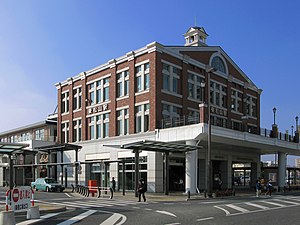| Revision as of 20:16, 9 May 2015 editFdizile (talk | contribs)Extended confirmed users754 edits Added {{update}} tag to article (TW)← Previous edit | Revision as of 20:17, 9 May 2015 edit undoFdizile (talk | contribs)Extended confirmed users754 edits Added {{lead too short}} tag to article (TW)Next edit → | ||
| Line 1: | Line 1: | ||
| {{lead too short|date=May 2015}} | |||
| {{update|date=May 2015}} | {{update|date=May 2015}} | ||
| {{Infobox Japan station | {{Infobox Japan station | ||
Revision as of 20:17, 9 May 2015
| This article's lead section may be too short to adequately summarize the key points. Please consider expanding the lead to provide an accessible overview of all important aspects of the article. (May 2015) |
| This article needs to be updated. Please help update this article to reflect recent events or newly available information. (May 2015) |
| 東松山 | |
|---|---|
 East entrance, November 2011 East entrance, November 2011 | |
| General information | |
| Location | 1-12-11 Yakyū-chō |
| Operated by | Tobu Railway |
| Line(s) | Tobu Tojo Line |
Higashi-Matsuyama Station (東松山駅, Higashimatsuyama-eki) is a railway station on the Tobu Tojo Line in Higashimatsuyama, Saitama, Japan, operated by the private railway operator Tobu Railway.
Lines
Higashi-Matsuyama Station is served by the Tobu Tojo Line from Ikebukuro in Tokyo. Located between Takasaka and Shinrinkōen, it is 49.9 km from the Ikebukuro terminus. All services, (TJ Liner, Rapid Express, Rapid, Express, Commuter express, Semi express, Local) stop at this station. During the daytime, the station is served by two Rapid and four Express trains per hour in each direction between Ikebukuro and Shinrinkōen or Ogawamachi stations.
Station layout
The station consists of two side platforms serving two tracks, with the station building located above the platforms. The platforms were originally island platforms serving four tracks, but the outer tracks were removed following completion of double-tracking beyond to Shinrinkōen.
This station has a season ticket sales office.
Platforms
| 1 | ■ Tobu Tojo Line | for Shinrinkōen, Ogawamachi, and Yorii |
| 2 | ■ Tobu Tojo Line | for Sakado, Kawagoe, and Ikebukuro |
-
View from the south end of platform 2 looking northward, February 2012
-
View from the north end of platform 1 looking southward, February 2012
-
View of the north end of the platforms showing the 2-car-length platform extensions, February 2012
Adjacent stations
| ← | Service | → | ||
|---|---|---|---|---|
| Tobu Tojo Line | ||||
| Sakado | TJ Liner | Shinrinkōen | ||
| Sakado | Rapid express | Shinrinkōen | ||
| Sakado | Rapid | Shinrinkōen | ||
| Takasaka | Express | Shinrinkōen | ||
| Takasaka | Commuter express | Shinrinkōen | ||
| Takasaka | Semi express | Shinrinkōen | ||
| Takasaka | Local | Shinrinkōen | ||
- TJ Liner services operate in the down direction only
History

The station was first opened on 1 October 1923 as Bushū Matsuyama Station (武州松山駅). The station was renamed Higashi-Matsuyama Station in October 1954 when Higashi-Matsuyama became a city. The station building was refurbished between 2008 and 2010 with the addition of lifts on either side.
From 17 March 2012, station numbering was introduced on the Tobu Tojo Line, with Higashi-Matsuyama Station becoming "TJ-29".
Passenger statistics
In fiscal 2011, the station was used by an average of 29,816 passengers daily. Passenger figures for previous years (boarding passengers only) are as shown below.
| Fiscal year | Daily average |
|---|---|
| 1950 | 4,046 |
| 1960 | 6,725 |
| 1970 | 11,448 |
| 1980 | 13,391 |
| 1990 | 17,131 |
| 2000 | 13,552 |
| 2010 | 13,650 |
Surrounding area
- Saitama Children's Zoo
- Saitama Prefectural Higashimatsuyama Girls' High School
- National Route 407
References
- ^ "Higashi-Matsuyama Station information" (in Japanese). Japan: Tobu Railway. Retrieved 9 January 2011.
- ^ Terada, Hirokazu (19 January 2013). データブック日本の私鉄. Japan: Neko Publishing. p. 225. ISBN 978-4-7770-1336-4.
{{cite book}}: Unknown parameter|trans_title=ignored (|trans-title=suggested) (help) - ^ Tobu Tojo Line Timetable, published March 2013
- 「東武スカイツリーライン」誕生! あわせて駅ナンバリングを導入し、よりわかりやすくご案内します (pdf). Tobu News (in Japanese). Tobu Railway. 9 February 2012. Retrieved 21 March 2012.
{{cite web}}: Unknown parameter|trans_title=ignored (|trans-title=suggested) (help) - Sawauchi, Kazuaki (October 2013). 東武鉄道東上線の歴史過程. The Railway Pictorial (in Japanese). 63 (880). Japan: Denkisha Kenkyūkai: p.18.
{{cite journal}}:|page=has extra text (help); Unknown parameter|trans_title=ignored (|trans-title=suggested) (help)
External links
- Higashi-Matsuyama Station information (Saitama Prefectural Government) Template:Ja icon
- Higashi-Matsuyama Station information (Tobu) Template:Ja icon
36°02′06″N 139°24′06″E / 36.034909°N 139.401658°E / 36.034909; 139.401658
Categories:

